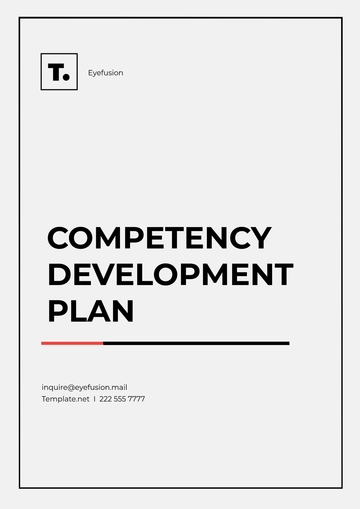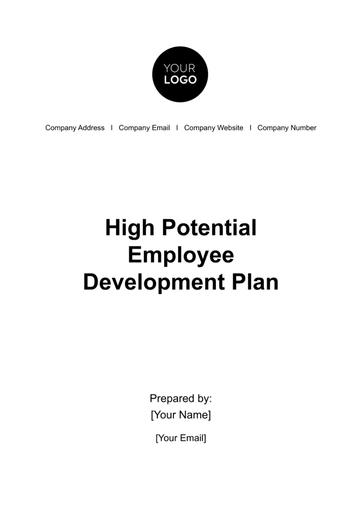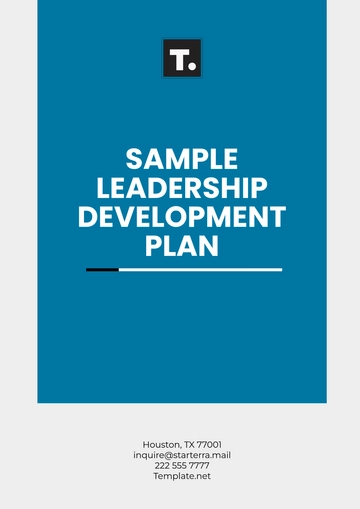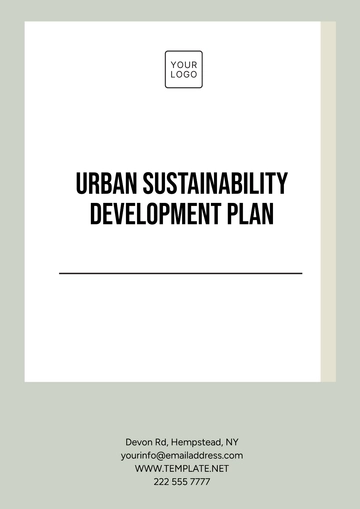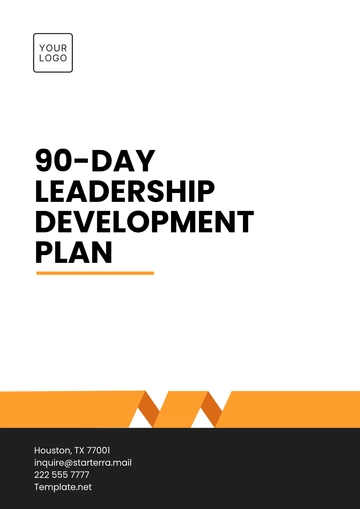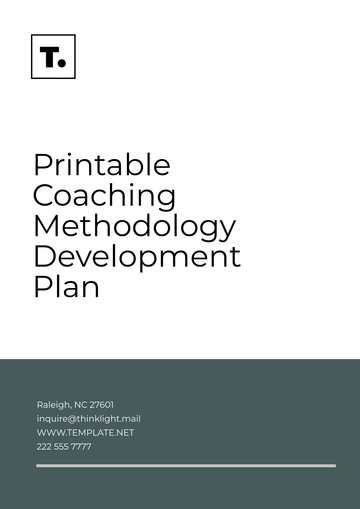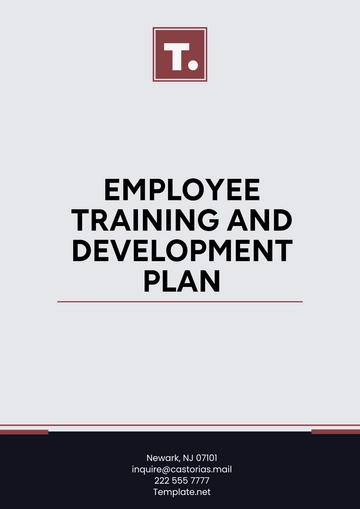Free Agriculture Market Development Plan

I. Executive Summary
The Agriculture Market Development Plan outlines the comprehensive strategy and actionable steps that [Your Company Name] will implement to achieve significant market growth, boost profitability, and solidify its position as a leader in the agriculture industry by the year [2050]. This plan is designed to navigate the evolving landscape of the agriculture sector, addressing both current challenges and future opportunities. Our approach focuses on leveraging advanced technologies, innovative practices, and strategic market positioning to drive growth. By conducting a thorough market analysis, identifying emerging trends, and understanding consumer needs, we aim to craft a robust framework that will guide our efforts in expanding our market share and enhancing our brand’s reputation.
Our plan emphasizes a multifaceted approach that includes diversifying our product offerings, optimizing pricing strategies, expanding distribution channels, and executing targeted promotional campaigns. We will also invest in research and development to stay ahead of industry advancements and respond proactively to market shifts. With a detailed action plan, budget allocation, and performance metrics, this strategy will ensure that [Your Company Name] not only meets but exceeds its growth objectives. By committing to these strategic initiatives, we envision a future where our company is at the forefront of agricultural innovation and excellence.
II. Company Overview
In this section, we provide a detailed introduction to [Your Company Name], outlining the foundational elements that define our identity and strategic direction. Understanding who we are and what we stand for is crucial as we embark on our journey to expand market presence and drive growth in the agriculture sector.
We begin with an overview of our company’s essential details, including contact information and online presence. Our Mission Statement reflects our commitment to pioneering sustainable agricultural solutions, while our Vision Statement sets forth our ambitious goals for the future. Our Core Values—Integrity, Innovation, Sustainability, Customer-Centricity, and Excellence—serve as the guiding principles for all our operations and strategic initiatives.
A. Company Information
[Your Company Name]
[Your Company Address]
[Your Company Number]
[Your Company Website]
[Your Company Social Media]
B. Mission Statement
Our mission is to lead innovation within the agriculture market by providing sustainable and efficient solutions to farmers worldwide.
C. Vision Statement
To be the foremost provider of agricultural services and products by [2050], contributing significantly to global food security and sustainable farming practices.
D. Core Values
Integrity, Innovation, Sustainability, Customer-Centricity, and Excellence.
III. Market Analysis
As we strategize for the future, a deep dive into the current state and future projections of the agriculture industry is essential for shaping our market development efforts. Our focus will be on understanding the major trends that will define the agriculture landscape by 2050, identifying and targeting our core customer base, and analyzing the competitive environment to find our unique position. By exploring these elements, we can craft informed strategies that leverage emerging opportunities and address potential challenges.
Target Market | Competitive Analysis |
|---|---|
The primary target market includes large-scale commercial farmers, agricultural cooperatives, and sustainable farming enterprises. | Key competitors include multinational agricultural firms, emerging agri-tech startups, and local agriculture businesses. Competitor analysis reveals a need for [Your Company Name] to differentiate through superior technology and customer service. |
IV. Development Strategy
To achieve our vision of becoming a leading force in the agriculture industry by [2050], [Your Company Name] will implement a multifaceted Development Strategy. This strategy focuses on leveraging innovative technologies, expanding market reach, and enhancing operational efficiencies. The following sub-sections outline the key components of our approach:
Strategy Area | Objective | Key Actions |
|---|---|---|
Product Innovation | Develop new products and services for farmers. |
|
Market Expansion | Increase market presence and reach new customers. |
|
Operational Efficiency | Improve productivity and reduce costs. |
|
Customer Relationship Management | Strengthen customer relationships for loyalty and repeat business. |
|
V. Marketing Plan
In a competitive agriculture market, a well-defined marketing plan is essential for establishing [Your Company Name] as a leader and achieving our growth objectives. Our marketing strategy is designed to enhance brand recognition, engage with our target audience, and drive successful promotional campaigns.
The plan consists of two main components: Branding and Positioning and Promotional Strategy. In the Branding and Positioning sub-section, we will focus on establishing our brand as a pioneer in sustainable agricultural innovation through strategic partnerships and industry event sponsorships. The Promotional Strategy sub-section outlines our approach to leveraging digital marketing, content creation, and influencer collaborations to effectively reach and engage our target customers, with special emphasis on launching campaigns during peak planting seasons.
A. Branding and Positioning
To establish [Your Company Name] as a leader in sustainable agricultural innovation, we will focus on elevating our brand presence and reinforcing our position within the agriculture industry. Our approach involves a combination of strategic initiatives designed to showcase our commitment to sustainability and technological advancement.
1. Brand Vision and Messaging
We will craft a clear and compelling brand message that highlights our dedication to innovative and eco-friendly agricultural solutions. This message will be consistently communicated across all platforms to build a strong and recognizable brand identity.
Develop a brand narrative that emphasizes our role in advancing sustainable agriculture.
Create cohesive visual and verbal brand assets, including a refreshed logo, tagline, and marketing materials.
2. Strategic Partnerships
Forming alliances with industry leaders, research institutions, and key stakeholders will be crucial for enhancing our visibility and credibility. These partnerships will help us reach new audiences and reinforce our commitment to agricultural innovation.
Identify and approach potential partners for collaborative projects and research.
Engage in joint initiatives that promote sustainability and showcase our expertise.
3. Industry Event Sponsorships
Participating in and sponsoring major agricultural events and conferences will position [Your Company Name] as a thought leader in the field. These events provide platforms for networking, sharing insights, and demonstrating our innovations.
Sponsor key industry events and conferences.
Set up booths, deliver presentations, and engage with attendees to showcase our products and services.
4. Public Relations and Media Outreach
We will execute a targeted public relations campaign to generate positive media coverage and build a favorable public image. This will include press releases, media interviews, and thought leadership articles.
Develop and distribute press releases about new products, partnerships, and achievements.
Secure media coverage through interviews and features in industry publications.
B. Promotional Strategy
Our promotional strategy aims to maximize [Your Company Name]'s reach and engagement with target customers through a well-coordinated mix of digital marketing, content creation, and influencer collaborations. This approach will focus on creating impactful campaigns and fostering strong relationships with both existing and potential customers.
1. Digital Marketing Initiatives
Utilize a variety of online channels to promote our products and services, focusing on both paid and organic methods to reach a broad audience and drive engagement.
Paid Advertising: Implement targeted ads on platforms like Google Ads, Facebook, and Instagram to reach specific demographics and drive conversions.
Search Engine Optimization (SEO): Optimize our website content for search engines to improve organic search rankings and attract potential customers.
2. Content Strategy
Develop and share valuable content that addresses the needs and interests of our target audience, establishing [Your Company Name] as a trusted source of agricultural knowledge and solutions.
Educational Content: Create blog posts, whitepapers, and videos about sustainable farming practices, new technologies, and industry trends.
Content Distribution: Share content through our website, social media channels, and email newsletters to engage with a wide audience.
3. Influencer Collaborations
Partner with industry influencers and thought leaders to extend our reach and credibility within the agricultural community.
Influencer Partnerships: Identify and collaborate with influencers who align with our brand values and have a significant following among farmers and agricultural professionals.
Campaign Development: Co-create content, host joint webinars, and engage in collaborative promotional activities to enhance our visibility.
4. Seasonal Promotional Campaigns
Launch targeted promotional campaigns during key planting seasons to capitalize on high activity periods and drive product adoption.
Seasonal Offers: Develop special promotions, discounts, and limited-time offers timed for peak planting and harvest periods.
Campaign Planning: Plan and execute marketing efforts that highlight product benefits and seasonal relevance to encourage customer engagement and sales.
VI. Financial Plan
A robust financial plan is essential for achieving our long-term growth objectives and ensuring the sustainability of [Your Company Name]. This section outlines our financial goals and strategies for revenue growth and cost management to support our vision for the future.
Revenue Projections details our ambitious targets for increasing revenue over the next five years, aiming for significant growth by [2055]. Cost Analysis focuses on a comprehensive approach to managing expenses efficiently while investing in key areas such as R&D, production, and marketing. Together, these elements will drive our financial success and support our strategic objectives.
A. Revenue Projections
To drive long-term growth, [Your Company Name] targets a 30% increase in revenue over the next five years. The following data illustrates our revenue goals, projecting a steady rise to reach $500 million by 2055.
B. Cost Analysis
Effective management of costs is essential for achieving our financial targets. This analysis outlines our planned expenditures for R&D, production, and marketing, ensuring resource efficiency and minimal waste, with a total budget of $300 million by 2053.
The Revenue Projections for [Your Company Name] reflect a strategic approach to achieving significant growth over the next five years. By targeting a 30% revenue increase and setting a goal of $500 million by 2055, we align our efforts with industry trends and market demands. This ambitious projection is supported by a robust plan involving market expansion, product innovation, and strategic partnerships designed to elevate our market position.
On the other hand, our Cost Analysis focuses on meticulous financial management to ensure resource efficiency. By allocating $300 million across R&D, production, and marketing over the next few years, we aim to drive innovation while maintaining operational excellence. This careful cost planning is essential for sustaining growth and maximizing profitability in a competitive agricultural market.
VII. Implementation Timeline
A clear and actionable timeline is crucial for the successful execution of our Agriculture Market Development Plan. The following table outlines key milestones and activities from [2050 to 2055], detailing our strategic initiatives and their respective timelines. This structured approach ensures that each phase of the plan is executed efficiently, with clear deadlines for achieving our growth and market expansion objectives.
Year | Major Milestone | Key Activities |
|---|---|---|
2050 | Market Entry & Initial Launch |
|
2051 | Expansion & Initial Growth |
|
2052 | Product Development & Marketing |
|
2053 | Strategic Partnerships & Scaling |
|
2054 | Market Consolidation & Optimization |
|
2055 | Review & Future Planning |
|
VIII. Evaluation and Monitoring
Ongoing evaluation and monitoring are essential for ensuring that [Your Company Name]'s Agriculture Market Development Plan remains on track and adapts to changing conditions. This section outlines our approach to assessing performance, identifying areas for improvement, and maintaining alignment with our strategic objectives. Through a structured evaluation process and continuous monitoring, we aim to achieve our long-term goals and respond proactively to market dynamics.
A. Key Performance Indicators (KPIs)
To measure the success of our market development strategies, we will track specific KPIs that reflect our progress towards achieving the plan’s goals. These indicators will help us gauge performance in critical areas such as market share growth, revenue generation, and customer satisfaction.
KPI | Description | Target |
|---|---|---|
Market Share Growth | Increase in market share within the agriculture sector. | 10% increase annually |
Revenue Growth | Yearly increase in total revenue. | 30% increase over five years |
Customer Satisfaction | Customer feedback on products and services. | 85% satisfaction rating |
Product Innovation | Number of new products or technologies developed. | 2 new products annually |
B. Evaluation Process
The evaluation process will involve periodic reviews and performance assessments to ensure that strategic goals are met. This process includes the following steps:
Quarterly Reviews: Conduct quarterly meetings to assess KPI performance, review financial reports, and evaluate project progress.
Annual Audits: Perform comprehensive annual audits to analyze market trends, financial health, and operational efficiency.
Stakeholder Feedback: Gather feedback from customers, partners, and employees to identify areas for improvement and refine strategies.
IX. Conclusion
The Agriculture Market Development Plan for [Your Company Name] presents a detailed and strategic roadmap to establish ourselves as a leader in the agriculture industry by [2050]. Our plan is designed to harness emerging technologies, respond to environmental challenges, and meet evolving consumer demands. Through a well-structured approach that includes market analysis, innovative development strategies, and a strong marketing plan, we are positioned to achieve significant growth and strengthen our market presence. Our focus on sustainable practices, advanced technologies, and efficient resource management will drive our efforts toward creating a resilient and forward-thinking agricultural enterprise.
By prioritizing key areas such as revenue growth, cost efficiency, and strategic partnerships, we are setting the stage for long-term success and industry leadership. The comprehensive evaluation and monitoring strategies outlined in our plan will ensure that we stay on track to meet our ambitious goals and adapt to changes in the market environment. As we move forward, our commitment to excellence, customer satisfaction, and sustainable development will guide our efforts and shape our future achievements. With a clear vision and actionable steps, [Your Company Name] is well-equipped to navigate the challenges and opportunities of the evolving agriculture sector and emerge as a prominent player in the industry by [2050].
X. Contact Information
For further information, please contact: [Your Name]
Email: [Your Email]
Phone: [Your Company Number]
- 100% Customizable, free editor
- Access 1 Million+ Templates, photo’s & graphics
- Download or share as a template
- Click and replace photos, graphics, text, backgrounds
- Resize, crop, AI write & more
- Access advanced editor
Expand your reach with the Agriculture Market Development Plan Template from Template.net. This fully customizable and editable template is ideal for planning your market growth strategies. Easily editable in our Ai Editor Tool, you can adapt it to your specific needs, ensuring a comprehensive and professional market development plan.
